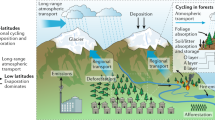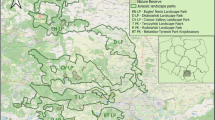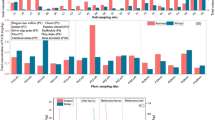Abstract
ANTHROPOGENIC semi-volatile organic compounds such as polycyclic aromatic hydrocarbons (PAHs) are highly lipophilic (which makes them likely to accumulate in animal tissue), and some are carcinogenic or mutagenic1. Although such compounds are known to accumulate in vegetation2–5, little is known about the quantitative role played by vegetation in removing them from the atmosphere. We have developed a mass-balance model for PAHs for the northeast of the United States, based on measurements of PAHs in soil and vegetation from Bloomington, Indiana, and published values for PAH concentrations and fluxes in air, water, sediments and soils. Our model shows that 44±18% of the PAHs emitted into the atmosphere from sources in this region are removed by vegetation. Although the equilibrium between the atmosphere and vegetation depends on ambient temperature6, we believe that most of the PAHs absorbed by vegetation at the end of the growing season are incorporated into the soil7,8 and permanently removed from the atmosphere.
This is a preview of subscription content, access via your institution
Access options
Subscribe to this journal
Receive 51 print issues and online access
$199.00 per year
only $3.90 per issue
Buy this article
- Purchase on Springer Link
- Instant access to full article PDF
Prices may be subject to local taxes which are calculated during checkout
Similar content being viewed by others
References
Evaluation and Estimation of Potential Carcinogenic Risks of Polynuclear Aromatic Hydrocarbons (Office of Research and Development, US Environmental Protection Agency, Washington DC, 1985).
Jones, K. C., Sanders, G., Wild, S. R., Burnett, V. & Johnson, A. E. Nature 356, 137–139 (1992).
Eriksson, G., Hensen, S., Kylin, H. & Strachan, W. Nature 341, 42–44 (1989).
Calamari, D. et al. Envir. Sci. Technol. 25, 1489–1495 (1991).
Hermanson, M. H. & Hites, R. A. Envir. Sci. Technol. 24, 666–671 (1990).
Simonich, S. L. & Hites, R. A. Envir. Sci. Technol. 28, 939–943 (1994).
Matzner, E. Wat. Air & Soil Pollut. 21, 425–434 (1984).
Smith, W. H., Hale, R. C., Greaves, J. & Huggett, R. J. Envir. Sci. Technol. 27, 2244–2246 (1993).
Ramdahl, T., Alfheim, I. & Bjorseth, A. in Mobile Source Emissions including Polycyclic Organic Species (eds Rondia, D., Cooke, M. & Haroz, R. K.) 277–298 (Reidel, Dordrecht, 1983).
Schulze, E.D. in Encyclopedia of Plant Physiology Vol. 12 B (eds Lange, O. L., Osmond, C. B. & Ziegler, H.) 615–676 (Springer, Berlin, 1982).
Jarvis, P. G. in Physiological Processes Limiting Plant Productivity (ed. Johnson, C. B.) 81–107 (Butterworths, London, 1981).
Redelfs, M. S., Stone, L. R., Kanemasu, E. T. & Kirkham, M. B. Argon, J. 79, 254–259 (1987).
Menzie, C. A., Potocki, B. B. & Santodonato, J. Envir. Sci. Technol. 26, 1278–1284 (1992).
Jones, K. C. et al. Envir. Sci. Technol. 23, 95–101 (1989).
Harrison, R. M. & Johnston, W. R. Sci. tot. Envir. 46, 121–135 (1985).
McVeety, B. D. & Hites, R. A. Atmos. Envir. 22, 511–536 (1988).
Gschwend, P. M. & Hites, R. A. Geochim. cosmochim. Acta. 45, 2359–2367 (1981).
Christensen, E. R. & Zhang, X. Envir. Sci. Technol. 27, 139–146 (1993).
Baker, J. E., Eisenrich, S. J. & Eadie, B. J. Envir. Sci. Technol. 25, 500–509 (1991).
Beymer, T. D. & Hites, R. A. Envir. Sci. Technol. 22, 1311–1319 (1988).
Kamens, R. M., Guo, J., Guo, Z. & McDow, S. R. Atmos. Envir. 24A, 1161–1173 (1990).
Alebic-Juretic, A., Cvitas, T. & Klasinc, L. Envir. Sci. Technol. 24, 62–66 (1990).
Pitts, J. N. Jr et al. Chemosphere 15, 675–685 (1986).
Kwok, E. S. C., Harger, W. P., Arey, J. & Atkinson, R. Envir. Sci. Technol. 28, 521–527 (1994).
Siak, J., Chan, T. L., Gibson, T. L. & Wolff, G. T. Atmos. Envir. 19, 369–376 (1985).
Schroeder, W. H. & Lane, D. A. Envir. Sci. Technol. 22, 240–246 (1988).
Author information
Authors and Affiliations
Rights and permissions
About this article
Cite this article
Simonich, S., Hites, R. Importance of vegetation in removing polycyclic aromatic hydrocarbons from the atmosphere. Nature 370, 49–51 (1994). https://doi.org/10.1038/370049a0
Received:
Accepted:
Issue Date:
DOI: https://doi.org/10.1038/370049a0
This article is cited by
-
Polycyclic aromatic hydrocarbon (PAH) biodegradation capacity revealed by a genome-function relationship approach
Environmental Microbiome (2023)
-
Variation in Polycyclic Aromatic Compound (PAC) Concentrations in a Norway Spruce Stand Close to a Major Traffic Route—Influence of Distance and Season
Water, Air, & Soil Pollution (2023)
-
Investigation of the spatial distribution of airborne polycyclic aromatic hydrocarbons using Rhytidiadelphus squarrosus in Tórshavn, Faroe Islands
Environmental Science and Pollution Research (2023)
-
Uptake and translocation of organic pollutants in Camellia sinensis (L.): a review
Environmental Science and Pollution Research (2023)
-
Spatiotemporal Distribution of Atmospheric Pollutants and Its Relationship with Vegetation Index in the Major Grain-Producing Areas of China
Water, Air, & Soil Pollution (2022)
Comments
By submitting a comment you agree to abide by our Terms and Community Guidelines. If you find something abusive or that does not comply with our terms or guidelines please flag it as inappropriate.



